INTRATHECAL BACLOFEN INFUSION PUMP
How does it work intrathecal baclofen therapy?
Spasticity is a tightening of the muscles. It happens when there is a damage to the brain or to the spinal cord, preventing the nerve impulses that cause it to release a chemical called GABA to reach the spinal cord. GABA is a natural neurotransmitter that allows the muscles to relax. Baclofen is similar to GABA and acts in the spinal cord, allowing muscles to relax.
The oral anti-spasticity medications may help some patients. But how are you oral medications are distributed throughout the body via the blood, only a very small amount (1 / 10, 000) reached the spinal cord. Some people with severe spasticity requiring high doses of oral medications, but the dose that reaches the spinal cord is not sufficient to control spasticity. In intrathecal baclofen therapy is administered directly into the fluid surrounding the spinal cord, not distributed to throughout the body. That is why control spasticity is achieved with extremely low doses, as this minimizes side effects and side effects and increase effectiveness in those patients not responding to oral administration of the drug. Intrathecal baclofen therapy is a therapy with non-destructive and reversible.
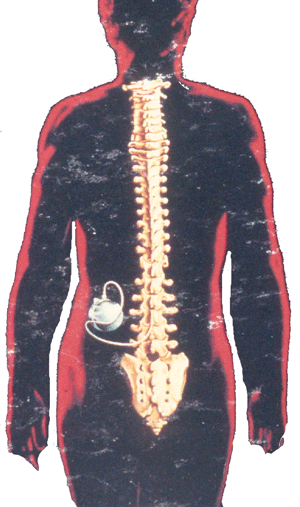 |
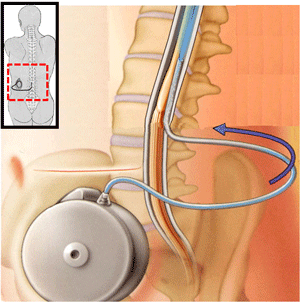 |
|
Implantable infusion’s pump for a continuos intrathecal admnistration of Baclofen
|
Implantable infusion’s pump for a continuos intrathecal admnistration of Baclofen
|
What are the steps to follow?
- MAKE A REASONABLE GOAL: To have a realistic goal is vital to achieve satisfaction in the outcome. This therapy can not return the capabilities that the patient has lost but can help reduce spasticity, which may be preventing the patient to develop the full potential has been post-injury.
- INFUSION TEST intrathecal baclofen: The way to determine whether the patient will benefit or not intrathecal baclofen therapy. The doctor injects a small dose of Baclofen in the fluid surrounding the spinal cord and evaluates muscle tone and spasticity. If the muscles relax during the test means that the intrathecal baclofen will be helpful for the patient. If no response must be other forms of treatment. The test dose reduces spasticity in 97% of patients with multiple sclerosis or spinal cord injury, and 86% of cases of severe spasticity secondary to cerebral palsy or brain injury.
- CONTINUOUS ADMINISTRATION Intrathecal Baclofen: A small pump surgically implanted under the skin of the abdomen. A small tube of silicone administered medication to the liquid pump of the spinal cord. The most common complications associated with implantable infusion pump system are infections and bends and disconnection of the catheter.
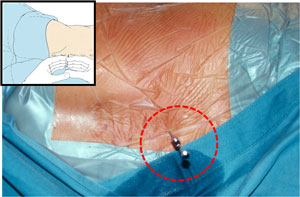
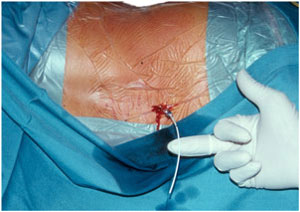 Lumbar puncture for implementation of intrathecal baclofen pumpIntrathecal catheter placement for intrathecal baclofen
Lumbar puncture for implementation of intrathecal baclofen pumpIntrathecal catheter placement for intrathecal baclofen
 Placement under the skin of the catheter to the intrathecal administration of BaclofenAbdominal wall incision for implantation of the pump Intrathecal Baclofen
Placement under the skin of the catheter to the intrathecal administration of BaclofenAbdominal wall incision for implantation of the pump Intrathecal Baclofen
 Load Baclofen infusion pump prior to implantationBaclofen pump ready for implantation under the skin of the abdominal wall
Load Baclofen infusion pump prior to implantationBaclofen pump ready for implantation under the skin of the abdominal wall - MAINTENANCE: The pump needs to be recharged periodically with Baclofen. You should adjust the dose administered.
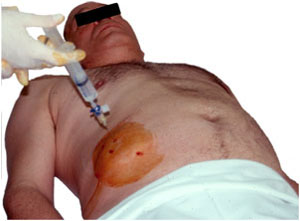 |
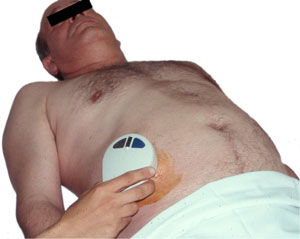 |
|
Recharging the Baclofen pump
|
Reprogramming of the pump once loaded with Baclofen
|
How is the test?
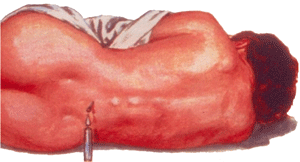 |
The doctor will apply local anesthesia to the skin of the lower back and through a lumbar puncture needle enters the thecal space, where fluid accumulates around the spinal cord. The medication is given below where the spinal cord ends. Only a minimal amount of medication is injected, but it is enough to have maximum effect in most patients. Baclofen need between half and 1 hour to get relax muscles. The maximum effect is achieved at approximately 4 hours after injection, and the effect lasts between 6 and 8 hours on average. When you pass the effect of medication, spasticity returns as it existed before the test.
|
|
Lumbar puncture for the test of intrathecal administration of baclofen
|
Measuring and comparing before and after the test, you can see what the response you would expect of intrathecal baclofen and whether or not it is worth carrying out.
Each patient responds differently to the test. Spasticity sometimes yields only partially, but other muscles are so lax that the patient can not stand up. In any case the effects are temporary and disappear within a few hours without sequelae.
Remember that the test is done just to see if this way of managing the Baclofen go or not to be effective. However, when medication is administered with the pump a dose is administered on a more regular and no bowling, with which the effect is maintained and no peaks. In any case once the pump is implanted will do various tests of programming so that is the one that best meets the needs of the patient.
Sometimes the outcome of the first test is inconclusive or negative. In that case you can repeat the test a second time with higher doses to see if this achieves the desired result. If not, you can repeat the test a third time and increase the dose again. If this is not achieved the desired result, it is likely that the patient is not a good candidate for intrathecal baclofen administration and should be attempted other forms of treatment.
During the test may have side effects such as excessive muscle relaxation, drowsiness, nausea, vomiting, headache, vertigo, etc. In any case, contact us if you see any unusual symptoms, but remember that all tend to be temporary and subside when the medication runs out the causes.